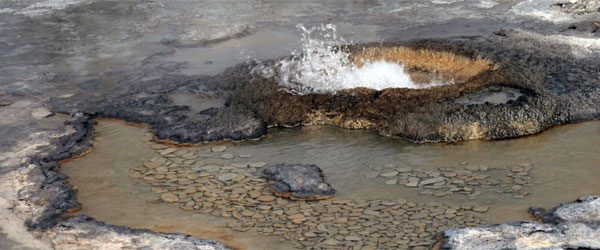The Taq behind PCR

Nobel Laureate Kary Mullis is generally credited with inventing the polymerase chain reaction, but his discovery owes a lot to a microbiologist who loved to travel, some refuted assumptions of what can live in hot springs, and a now-closed field station in Yellowstone National Park.
Here’s the story.
In the 1960s, Thomas Brock was a biologist at Indiana University whose interest was shifting toward microbial ecology; he began studying microorganisms in intertidal pools, freshwater lakes, cold springs, and finally, geysers and hot springs.
Brock had a travel bug, and was increasingly interested in doing field ecology. He started a field research station in Yellowstone National Park, though he says at first he wasn’t interested in geysers. At the time, scientists believed that bacteria optimally lived at about 55°C, and that nothing lived above 73°C. So, he assumed there was nothing to find.
But, he soon found pink bacterial filaments living in the Octopus Hot Spring at temperatures above 80°C. The bacteria: Thermus aquaticus, which contains the DNA polymerase that ultimately became the backbone of PCR.
The key to making PCR work is a heat-tolerant enzyme that can endure conditions in the chain reaction. Since Thermus aquaticus was the first organism known to exist (and reproduce) at these high temperatures, it naturally became the focus point of Mullis’ later invention.
In a Journal of Bacteriology paper with an honors undergraduate Hudson Freeze (now head of glycoprotein research at the Burnham Institute in La Jolla, Calif.), Brock introduced the new species in 1969. It was the first instance of an organism thriving at extremely high temperatures.
T. aquaticus, it turned out, is ubiquitous at high temperatures. Brock found the bacteria in hot springs in California, soil in a tropical-temperature greenhouse, and even the hot water supply at Indiana University!
The bacteria are also in hot springs worldwide, including Japan, New Zealand, and Iceland. But Yellowstone was the easiest to study; being a national park, habitats were not destroyed or developed into spas and resorts, which made international research challenging.
Ironically, Brock at first had no interest in Yellowstone, because of the park’s reputation in the 1950s and 60s as more of an amusement park than natural habitat.
Brock continued his work on extreme thermophiles, but closed the Yellowstone research station in 1975.
Only several years later, when PCR technology – which depends on the heat-tolerant DNA polymerase found in Taq – was announced did interest in his work rebound.
Scientific and biotechnology interest in Yellowstone has rebounded, too. The National Park Service, wizened to the fact that it had, free of charge, owned the wellspring of a $300 million industry, now manages biology, chemistry and biotechnology projects at the park. Researchers worldwide now have been issued permits to perform microbe research, and part of that permit initially involved sharing benefits of the research with the Park Service. As one Park Service manager said, “When you see the money that’s being made, that’s hard for a starving bureaucrat to overlook.”
However, the Park Service was sued over the benefit-sharing arrangement, and those arrangements have been on hold since 1999. The Park Service says it is now conducting an environmental impact study to determine the overall impact of benefit-sharing agreements with biotechnology companies.
But hey, it’s for a good cause.
Further Reading:
1. Thomas Brock, Life at High Temperatures (web site)
2. Thomas Brock. 1972. The Upper Temperature Limit for Eukaryotic Organisms, Proc. Natl. Acad. Sci. USA. 69(9): 2426–2428
3. National Park Service: Yellowstone bioprospecting permit controversy
4 Comments
Leave a Comment
You must be logged in to post a comment.
Brock TD, Freeze H. Thermus aquaticus gen. n. and sp. n., a nonsporulating
extreme thermophile. J Bacteriol. 1969 Apr;98(1):289-97. PubMed PMID: 5781580;
PubMed Central PMCID: PMC249935.
Bonnie,
Great question. T. aquaticus DNA is intact at those high temperatures; in fact, Brock could not culture it at “normal” room temperature. The question is, how is Taq DNA and polymerase different so it can survive? I didn’t find anything that answered that during my research (and Brock worked as a microbiologist, not a chemist, but I’ll check it out. Maybe another story….
This brings to mind an interesting question that I’ve never previously pondered. Does thermophile DNA exist in a denatured state? If not, what prevents it from denaturing at temperatures that researchers use all the time to denature DNA?